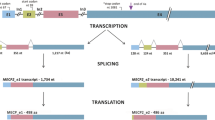Abstract
Pseudogenes—sequences which are homologous to functional genes but which contain mutational changes precluding the formation of a functional product—seem to be a common feature of eukaryotic genomes. Such sequences were first described in the 5S gene of Xenopus laevis1 and have since been found in several gene families including those of the α- and β-globins of several species2–10, immunoglobulin Vκ genes11, the actin genes of Dictyostelium12 and the small nuclear RNA genes of man13. Among the globin pseudogenes, there appear to be two kinds of structural organization: genes that have retained their intervening sequences4–7 and those that have lost them completely2,3. A possible explanation for the generation of such intron-lacking genes involves the reverse transcription of a processed mRNA to form cDNA, and the introduction of this cDNA copy into the genome either by recombinant heteroduplex formation2, insertion into a staggered chromosomal break3, or via a retrovirus intermediate14. Here we report the complete sequence of a human β-tubulin pseudogene. The sequence data reveal the absence of any intervening sequences, and the presence, in the genome, of an uninterrupted 17 base-pair (bp) tract of A residues 14 base-pairs 3′ to a poly(A) signal (AATAAA)15. This sequence organization corresponds closely to the sequence organization of the poly(A) signal and poly (A) tract in a β-tubulin mRNA16.
Similar content being viewed by others
References
Jacq, D., Miller, J. R. & Brownlee, G. G. Cell 12, 109–120 (1977).
Nishioka, Y., Leder, A. & Leder, P. Proc. natn. Acad. Sci. U.S.A. 77, 2806–2809 (1980).
Vanin, E. F., Goldberg, G. I., Tucker, P. W. & Smithies, O. Nature 286, 222–226 (1980).
Jahn, C. L. et al. Cell 21, 159–168 (1980).
Lacy, E. & Maniatis, T. Cell 21, 545–553 (1980).
Proudfoot, N. J. & Maniatis, T. Cell 21, 537–554 (1980).
Cleary, M. L., Schon, E. A. & Lingrel, J. B. Cell 26, 181–190 (1981).
Lacy, E., Hardison, R. C., Quon, D. & Maniatis, T. Cell 18, 1273–1283 (1979).
Proudfoot, N. J., Shander, M. H., Manley, J. L., Gefter, M. & Maniatis, T. Science 209, 1329–1336 (1980).
Leder, A., Swan, D., Ruddle, F., D'Eustachio, P. & Leder, P. Nature 293, 196–200 (1981).
Bentley, D. L. & Rabbitts, T. H. Nature 288, 730–733 (1980).
Firtel, R. A., Timon, R., Kimmel, A. R. & McKeown, M. Proc. natn. Acad. Sci. U.S.A. 76, 6206–6210 (1979).
Van Arsdell, S. W. et al. Cell 26, 11–17 (1981).
Goff, S. P., Gilboa, E., Witte, O. N. & Baltimore, D. Cell 22, 777–785 (1980).
Proudfoot, N. J. & Brownlee, G. G. Nature 263, 211–214 (1976).
Valenzuela, P. et al. Nature 289, 650–655 (1981).
Cowan, N. J., Wilde, C. D., Chow, L. T. & Wefald, F. Proc. natn. Acad. Sci. U.S.A. 78, 4877–4881 (1981).
Wilde, C. D., Chow, L. T., Wefald, F. & Cowan, N. J. Proc. natn. Acad. Sci. U.S.A. 79, 96–100 (1982).
Wilde, C. D., Crowther, C. E. & Cowan, N. J. J. molec. Biol. (in the press).
Sanger, F., Coulson, A. R., Barrell, B. G., Smith, A. J. H. & Roe, B. J. molec. Biol. 143, 161–178 (1980).
Grunstein, M. & Hogness, D. S. Proc. natn. Acad. Sci. U.S.A. 72, 3961–3965 (1975).
Cleveland, D. W. et al. Cell 20, 95–195 (1980).
Rigby, P. W. J., Dieckmann, M., Rhodes, C. & Berg, P. J. molec. Biol. 113, 237–251 (1977).
Benton, W. D. & Davis, R. W. Science 196, 180–181 (1977).
Staden, R. Nucleic Acids Res. 8, 3673–3694 (1980).
Author information
Authors and Affiliations
Rights and permissions
About this article
Cite this article
Wilde, C., Crowther, C., Cripe, T. et al. Evidence that a human β-tubulin pseudogene is derived from its corresponding mRNA. Nature 297, 83–84 (1982). https://doi.org/10.1038/297083a0
Received:
Accepted:
Issue Date:
DOI: https://doi.org/10.1038/297083a0
- Springer Nature Limited
This article is cited by
-
Genomic rearrangements of the BRCA1 gene in Chilean breast cancer families: an MLPA analysis
Breast Cancer Research and Treatment (2011)
-
The expansion of the metazoan microRNA repertoire
BMC Genomics (2006)
-
Mechanisms of Taxol resistance related to microtubules
Oncogene (2003)
-
Fluorescencein situ hybridization with rDNA probes on chromosomes of two nucleolus organizer region phenotypes of a species ofEigenmannia (Pisces, Gymnotoidei, Sternopygidae)
Chromosome Research (1996)
-
Modulation of apoptosis by the widely distributed Bcl-2 homologue Bak
Nature (1995)





